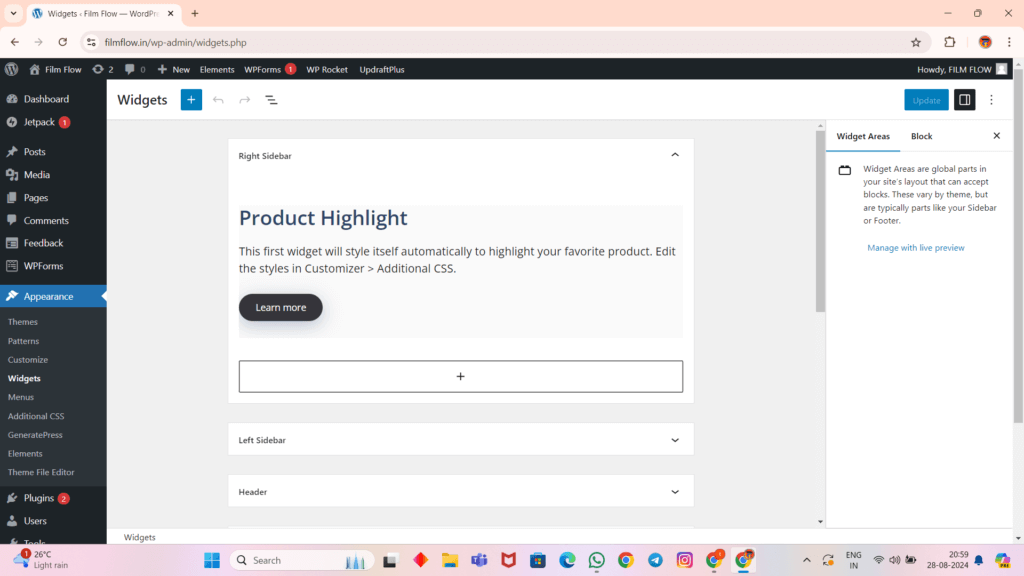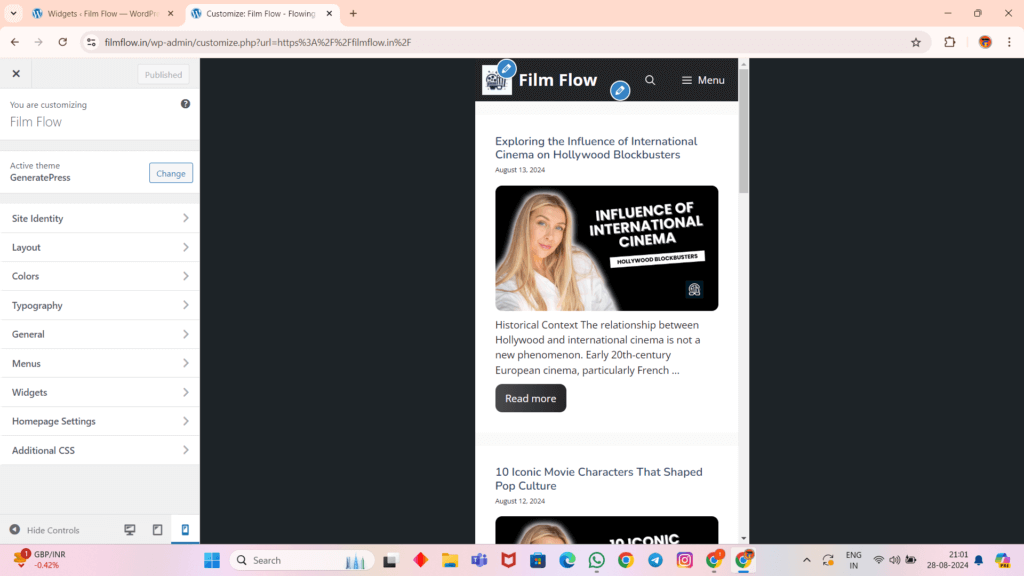Introduction to WordPress Theme Customization
Customizing your WordPress theme is one of the most powerful ways to bring your personal style and brand to life. Whether you’re creating a blog, a business site, or an online portfolio, the design and layout should reflect your vision. By customizing your WordPress theme, you gain control over the look, feel, and functionality of your site, allowing it to stand out from the competition. This step-by-step guide will walk you through the process, ensuring that you create a site that not only looks professional but also offers a seamless user experience.
Understanding customizing WordPress theme is essential for anyone looking to build a unique and engaging online presence. While WordPress offers thousands of themes, the ability to customize a theme lets you tweak everything from color schemes to typography and layout, giving you the creative freedom to craft a site that truly represents your brand. Whether you’re a seasoned developer or a beginner, this guide will help you navigate the ins and outs of theme customization.
If you’re ready to take your website to the next level, customizing your WordPress theme will allow you to fully optimize your site for both aesthetics and performance. Not only will this enhance the user experience, but it will also play a crucial role in SEO, helping your site rank higher in search results. Let’s dive into why and how you can get started with customizing your WordPress theme for optimal impact.
Why Customize Your WordPress Theme?
Customizing your WordPress theme gives you the flexibility to make your website truly unique. While there are many free and premium themes available, they may not always align perfectly with your vision. By personalizing your theme, you can ensure that your site stands out, whether you’re highlighting your brand colors, changing layouts, or adding special features. A customized theme also reflects your site’s personality, giving visitors a memorable experience that sets your site apart from others.
Moreover, customization allows for improved functionality. With the right adjustments, you can make your site more user-friendly, increase engagement, and improve navigation. Every tweak you make can be designed to support your specific goals—whether it’s to showcase a portfolio, run a blog, or sell products. Customizing your WordPress theme ensures that every element of your site serves a purpose, tailored to your audience’s needs.
In an online world where first impressions are everything, customizing your WordPress theme is the key to making a lasting impact. Not only does it give you control over your website’s design and functionality, but it also boosts your credibility and professionalism, which can directly affect visitor retention and conversion rates.
Benefits of Customizing Your WordPress Theme
The benefits of customizing your WordPress theme go far beyond aesthetics. One of the major advantages is the ability to tailor your site’s functionality to your specific needs. Whether it’s integrating advanced features, improving mobile responsiveness, or enhancing the user interface, customization enables you to build a site that works for both you and your audience. With these changes, your site can perform better and offer visitors an exceptional experience.
Another benefit is brand alignment. By customizing your WordPress theme, you ensure that your website’s design is consistent with your brand identity. From logo placement to font choices and colors, these small but crucial changes make a big difference in how your brand is perceived. A well-customized site builds trust with your visitors, making them more likely to engage with your content and return in the future.
Lastly, customizing your WordPress theme can have a direct impact on your site’s SEO performance. By optimizing the layout, speed, and user experience, you make your site more search-engine friendly. This means your site will have a better chance of ranking higher on Google, driving more traffic to your content, and ultimately increasing conversions.
Step 1: Choosing the Right Theme for Customization
Before diving into customization, selecting a theme that supports easy customization is crucial. Choose themes known for flexibility, such as Astra, GeneratePress, or OceanWP. These themes are lightweight, customizable, and compatible with popular page builders like Elementor.

Step 2: Customizing with WordPress Customizer
The WordPress Customizer is your first stop for theme customization. You can access it by navigating to Appearance > Customize in your WordPress dashboard. This tool allows you to change various aspects of your theme, including:

- Site Identity: Customize the basic site settings like site title , logo, and tagline.
- Colors and Fonts: Change your site’s color scheme and typography.
- Header and Background: Modify header images, background colors, and more.
- Layout Options: Adjust layout settings like sidebar positions, footer layouts, etc.
These changes are live, allowing you to see the results immediately. Make sure to save your changes once you’re satisfied.
Step 3: Adding Custom CSS
For those who want more control, adding custom CSS is a great way to make minor tweaks. You can add CSS directly through the Customizer under Additional CSS. For example, if you want to change the font size of your blog titles, you can add a simple CSS code:
cssCopy codeh1.entry-title {
font-size: 28px;
}

This option is perfect for those who wish to make adjustments that are not available through the Customizer settings.
Step 4: Using Page Builders
Page builders like Elementor, Beaver Builder, and WPBakery offer drag-and-drop customization capabilities, making it easy to create custom layouts without any coding. With these plugins, you can design custom headers, footers, and page sections. Simply select a module, drag it into place, and customize it to fit your style. Page builders are a powerful way to enhance your theme’s appearance without affecting performance significantly.

Step 5: Custom Widgets and Menus
Widgets allow you to add various elements to your sidebar, footer, or other widget areas. To add or customize widgets, go to Appearance > Widgets. You can include custom menus, recent posts, social media links, and more. Custom menus can be created under Appearance > Menus, where you can add pages, categories, and custom links to create easy navigation for your readers.

Step 6: Testing and Previewing Changes
After making customizations, it’s essential to test and preview your changes. Check how your site looks on different devices like mobiles, tablets, and desktops. Ensure that your customizations do not break any functionality and that your site remains user-friendly and responsive.

Conclusion: Final Thoughts on Customizing Your WordPress Theme
Customizing your WordPress theme is an empowering journey that allows you to bring your creative vision to life while ensuring your website stands out in a crowded digital landscape. By taking the time to personalize your theme, you’re not just enhancing the aesthetic appeal of your site but also boosting its functionality, making it more user-friendly and performance-driven. Whether you’re a beginner or an experienced developer, this process is a crucial step in building a website that is truly your own.
As you dive deeper into customizing your WordPress theme, remember that this process is about more than just design—it’s about creating a seamless experience for your visitors. A well-customized theme can enhance your site’s credibility, improve navigation, and reflect your brand identity, all while making your website more engaging. By aligning the customization with your goals and audience, you’re investing in the long-term success of your site.
In conclusion, customizing your WordPress theme offers endless possibilities for creativity and optimization. The time and effort you put into personalizing your site will pay off in terms of better user experience, higher SEO rankings, and a stronger connection with your audience. Stay dedicated to refining your theme, and watch your website evolve into a true reflection of your vision and goals.
Tips for Maintaining Your Customized Theme
Once you’ve completed customizing your WordPress theme, ongoing maintenance is essential to ensure that your website remains efficient and up to date. One key tip is to regularly check for theme and plugin updates. Keeping your theme updated ensures that you have the latest features, security patches, and bug fixes. Failing to update could leave your site vulnerable to security issues or slow down its performance.
Another important aspect of maintaining your customized theme is to back up your website regularly. Before making any major changes or updates, it’s wise to create a backup to avoid losing your hard work. This helps you identify areas where further customization or optimization may be needed to keep your site running smoothly.
Lastly, be mindful of how new customizations impact the overall user experience and load time. While adding new features can enhance functionality, too many changes at once can slow your site down. Regularly test the speed and responsiveness of your site to ensure it continues to provide a fast and seamless experience for your visitors.
How to Keep Your Customizations SEO-Friendly
While customizing your WordPress theme, it’s essential to prioritize SEO to ensure that your site ranks well in search engine results. One of the first steps to keeping your customizations SEO-friendly is optimizing your site’s speed. Fast load times not only improve the user experience but are also favored by search engines. Consider using lightweight themes, compressing images, and minimizing unnecessary plugins to keep your site performing at its best.
Another SEO-friendly practice during customizing your WordPress theme is ensuring that your website is mobile-responsive. With the majority of users accessing websites via mobile devices, search engines prioritize mobile-friendly sites. Choose a theme that is responsive out of the box, or customize it to ensure that your site looks and functions well on all devices.
Lastly, make sure that your customizations include proper heading structures, alt texts for images, and internal linking. These small but significant tweaks can improve your site’s visibility to search engines, boosting its rankings. By keeping SEO in mind throughout the customization process, you’ll ensure that your website not only looks great but also attracts more organic traffic over time.


